Let’s Get Better Control of CPS Energy
San Antonio’s citizens need to know that city-owned CPS Energy is quietly and without public input committing our city to natural gas power plants until at least 2050. It has recently spent $785 million of our money to buy two gas power plants and is seeking to build more gas power plants (S.A. Express-News 5/26/24). This is especially troubling because it is now understood that natural gas (methane) is actually as damaging as coal because of the leaks in the processing and delivery of methane. Methane is 80 times more potent than CO2 as a greenhouse gas over a 20 year period.
The city council needs to take responsibility for these major policy decisions by CPS Energy, particularly since renewables and battery storage are now less expensive to develop than natural gas plants. CPS Energy presently has more capacity than it needs, so there is no urgency to develop new sources. Texas is presently the hottest market in the country (no pun intended) for utility-scale storage batteries. Enormous digitally controlled batteries now prevent power outages across Texas when demand surges. Nationally, battery storage capacity is expected to double this year. Why are ratepayers incurring billions for natural gas plants when renewables and storage will meet future needs? And there has been almost no effort locally to promote the retrofitting of buildings to conserve energy.
The city’s utility bond ordinances make clear that the city council can control the CPS Board makeup, rather than continuing to allow the board to appoint its own members. The ordinances also state that the CPS Board is required to follow policies set by the city council. With climate change causing or soon to cause a major disruption in citizens’ health and safety (look at Houston after Hurricane Beryl), it is time for the city council to exercise its powers over the utility we all own. It is not acceptable that the city allows the lives of low-income citizens to be jeopardized by unaffordable energy, especially when the city is the utility company.
One of the reasons for the city’s reluctance to act is that CPS Energy is generating huge unbudgeted sums of money during the summer months (last year $247 million) by selling excess capacity from fossil fuel power plants to the state grid at high rates. The city takes 14% of CPS Energy’s gross revenue. Last summer the city council did not know what to do with the excess being paid to it by CPS Energy. CPS Energy has become the tail that wags the dog, providing 25%-30% of the City’s total revenue.
In the fall of 2020 citizens from the Sierra Club, Public Citizen, Southwest Workers Union, and other groups gathered 14,000 signatures of 20,000 needed, to place a city charter amendment petition on the ballot. If approved by the voters, the amendment would have given the city council more control over the utility and would have required policies to reduce fossil fuel emissions. The petition effort was blocked by a court order from Travis County, obtained by CPS Energy without notice to the citizens. I represent two San Antonio citizens in a suit against CPS Energy to obtain a court finding that the Travis County judgment is void; the case is presently on appeal in Austin. Meanwhile, in the 2023 legislative session the Texas legislature passed a law making any “climate charter” amendment to a city charter subject to legislative approval before it can be voted on.
But the city and the state cannot stop us from organizing to elect city council representatives in 2025 who will require the city’s utility to act responsibly to rapidly move away from fossil fuels and to protect our low-income residents from the changing climate. The city has the duty, recognized in its 2019 Climate Action and Adaptation Plan, to do its part in effectively addressing the global climate crisis.
by Darby Riley, Alamo Group Political ChairVisit to Talking Tree Farm
Hello Friends of the Environment, join us Sunday, October 13 from 11:00 a.m. to 1:00 p.m. for an informative visit to Talking Tree Farm, a natural farming operation in Schertz. Learn about their market garden, greenhouses, orchard and food forest, chicken coops, beehives, and composting process.
Stick around at 1:00 p.m. for a Community Plant Sale offering vegetable starts, fruit trees, and bags of rich compost. Attached is the Talking Tree Farm flyer. Please register via the link or QR code. Carpooling from Eco Centro is available.
There are also educational opportunities and supporting events hosted by Eco Centro at San Antonio College. Together, we can foster environmental awareness and change! All the best,
by Judith Temple and Arthur Dawes, EcoSA Tour OrganizersDr. Andrew Gluesenkamp: Reintroducing the Texas Horned Lizard to its Native Habitat in the American Southwest
Tuesday, October 15th
6:00 pm
Meeting schedule
| Informal get-to-know-you | 6:00 pm to 6:15 pm |
| Announcements | 6:15 pm to 6:30 pm |
| Featured program | 6:30 pm to 8:00 pm |
Venue
This is an in-person meeting at:
William R. Sinkin Eco Centro, 1802 North Main Avenue
Map
Program topic
Dr. Gluesenkamp will discuss the Texas Horned Lizard Reintroduction Project which works with private landowners to introduce zoo-hatched lizards into native habitats from which they have disappeared in recent decades.The Texas horned lizard (Phrynosoma cornutum), commonly known as the "horned toad", "horny toad", or "horned frog" due to its appearance, is neither a toad nor a frog. Its historic geographic distribution includes portions of Colorado, Kansas, Oklahoma Texas, New Mexico and Arizona, as well as much of northern Mexico, but the horned lizard has disappeared from almost half of this range since the mid-1900’s. Pressures on populations have included fragmentation of habitat; loss of habitat due to real estate development, agricultural land use, road construction, and replacement of native grasses with non-native species; pesticides; and collecting for the pet trade plus predation by domestic dogs and cats.
The Texas Horned Lizard Reintroduction Project, led by the Center for Conservation and Research (CCR) at San Antonio Zoo, seeks to restore the Texas horned lizard population by working with private landowners to introduce zoo hatched lizards in areas where it has disappeared in recent decades. The CCR provides management guidance and assistance to landowners who wish to manage their property to increase native biodiversity, including with horned lizards. Candidate release sites are assessed on several criteria using remote habitat ranking and boots-on-the-ground surveys.
Effective post-release monitoring is critical for the success of the project. Release sites are monitored for horned lizard activity at regular intervals. To do this effectively and efficiently, the CCR has partnered with Paul Bunker, owner of Chiron K9, who has developed the Horned Lizard Detection Canine Network, a group of volunteer handlers and their canines who are trained to find horned lizards (but not harm them!).
By re-establishing horned lizard populations and encouraging voluntary management that benefits native biodiversity, CCR hopes this project will help to improve native biodiversity across Texas, and promote awareness and appreciation of this species for the benefit and enjoyment of present and future generations. CCR’s long-term goal is to develop replicable methodologies to share with other conservation entities to ultimately ensure the return of this species, beloved especially by those who grew up in Texas, to places where its absence is so deeply felt.
About our speaker
Dr. Gluesenkamp conducts conservation research on central Texas groundwater salamanders, Mexican and Chinese cavefishes, mud turtles, and other projects focusing on rare and threatened invertebrates, fish, reptiles, amphibians, and their ecosystems. He is actively involved in various projects in Texas and Mexico, in addition to leading San Antonio Zoo’s Texas Horned Lizard Reintroduction Project.
Dr. Gluesenkamp has a PhD in zoology (2001, University of Texas). He has participated in surveys of rare and threatened amphibians in the San Joaquin Valley, been curatorial assistant in the Zoology Museum of UC-Davis, conducted independent fieldwork on reptiles and amphibians in Belize and Ecuador. While working on his PhD he discovered his love of caving and biospeleology, which led him to work as a karst specialist and cave biologist. He conducted numerous grant-funded projects on rare and endangered salamanders in central Texas as well as research on karst organisms in California, Texas, Cuba, and Mexico before becoming the State Herpetologist for the Texas Parks and Wildlife Department.
Dr. Gluesenkamp has served as Director of San Antonio Zoo’s Center for Conservation and Research since September 2016. He conducts conservation research on central Texas groundwater salamanders, Mexican and Chinese cavefishes, mud turtles, and other projects focusing on rare and threatened invertebrates, fish, reptiles, amphibians, and their ecosystems. He is actively involved in various projects in Texas and Mexico, including leading San Antonio Zoo’s Texas Horned Lizard Reintroduction Project.
Sources
- Texas horned lizard (Wikipedia)
- Texas Horned Lizard Reintroduction Project/
- Andy Gluesenkamp (LinkedIn profile)
The Alamo Group of the Sierra Club holds its general meetings the 3rd Tuesday of most months. They're always free and open to the public.
A Few More Spots in Northern New Mexico
In the February 2023 issue of this newsletter we had an article Across Southern New Mexico (though only a fraction of the interesting stuff there was mentioned). This is about a few spots to the north.
A good place to camp just before getting into New Mexico is Muleshoe National Wildlife Refuge (NWR). At-large free campsites with a toilet and water spigot. This is 73 miles northwest of Lubbock west off TX hwy 214, then drive past the headquarters to the campground on the left. There are some ponds/marshes and trails for observing waterfowl, particularly over-wintering sandhill cranes, as at Bitter Lakes NWR, mentioned in the Feb 2023 article. Just northwest of Muleshoe NWR is Grulla NWR on the west side of the New Mexico state line. Grulla is Spanish for crane; this is shorthand for the sandhill cranes. Sorry to say I have not been at these places when the cranes are there, only at Bitter Lakes.
When are the cranes in residence? Best to contact the preserves, but seems they arrive from the north early November and return early March. Details on these birds in a Nature Conservancy article.
If we wish to wander north of I-40 in eastern New Mexico, east of I-25, we might visit Mills Canyon of the Canadian River and Sabinoso Wilderness (article November 2022). For the latter a good AWD vehicle is essential, but another entrance may eventually be created due to land expansion. These are north-northeast of Santa Rosa.
In Carson National Forest
From Muleshoe we can drive west on US-84 through Clovis, Santa Rosa and Las Vegas to hwy 518, which goes north and west through Carson NF to Taos. From 518 we can turn southwest to a trailhead for Jicarita Peak, picture below, and SummitPost.org page. There are a bunch of other hikes and some campgrounds along hwy 518.
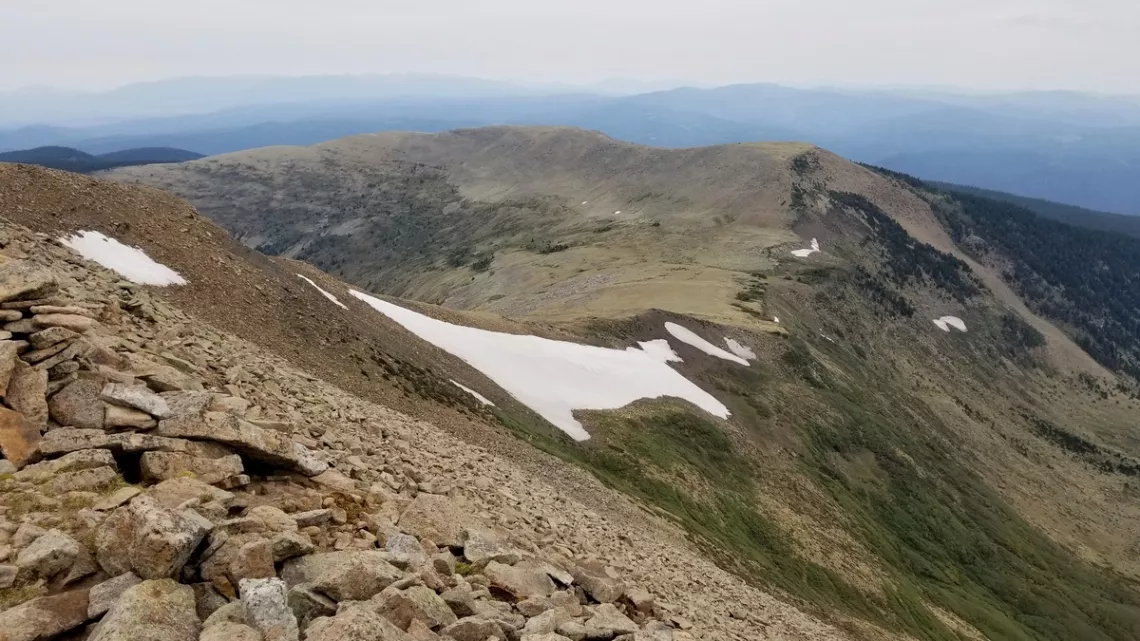
For a 2022 trip after doing Jicarita Peak (picture above) I saw could do Ripley Point, 2.6 miles north of the former. Can get there driving southeast from the west side of Carson NF on hwy 73. But this was after the enormous Hermits Peak and Calf Canyon wildfires late Spring 2022, so wasn't very scenic, therefore never mind pictures. Vast areas on mountains above hwy 512 were covered with dead trees. There were miles of firebreaks about 50 yards wide constructed along ridges and existing forest service roads not burned. A story for hiking buddies has been about one of them and her fusion powered AI-controlled anti-grav barge with tractor beam; could have collected wood for 1000 campfires in a minute. Much had already been collected, so thankfully the fuel load was greatly reduced.
Maybe more fun were hikes to Gold Hill and Wheeler Peak from Taos Ski Area (article March 2021).
In Santa Fe National Forest
From Taos we can drive not far southeast to Santa Fe, and then hwy 475 northeast to Ski Santa Fe. From there is a pretty darn appealing loop to the northeast. Including detours that is 19 mi, climb about 2000' three times across Penitente and Lake peaks and up the lollipop stem to Santa Fe Baldy, and to Nambe Lake in the center of the loop. Crossing some creeks with at-large campsites. I was only doing the loop, a 10 mi dayhike, and got to the vista in the picture below. There had been some thunder and big clouds; didn't want to be on that bare ridge in a thunderstorm, so turned around 2/3 of the way around the loop. Nice hike anyway. Should have done the hike counter-clockwise and climbed Penitente and Lake peaks first. Details at HikingProject.com.
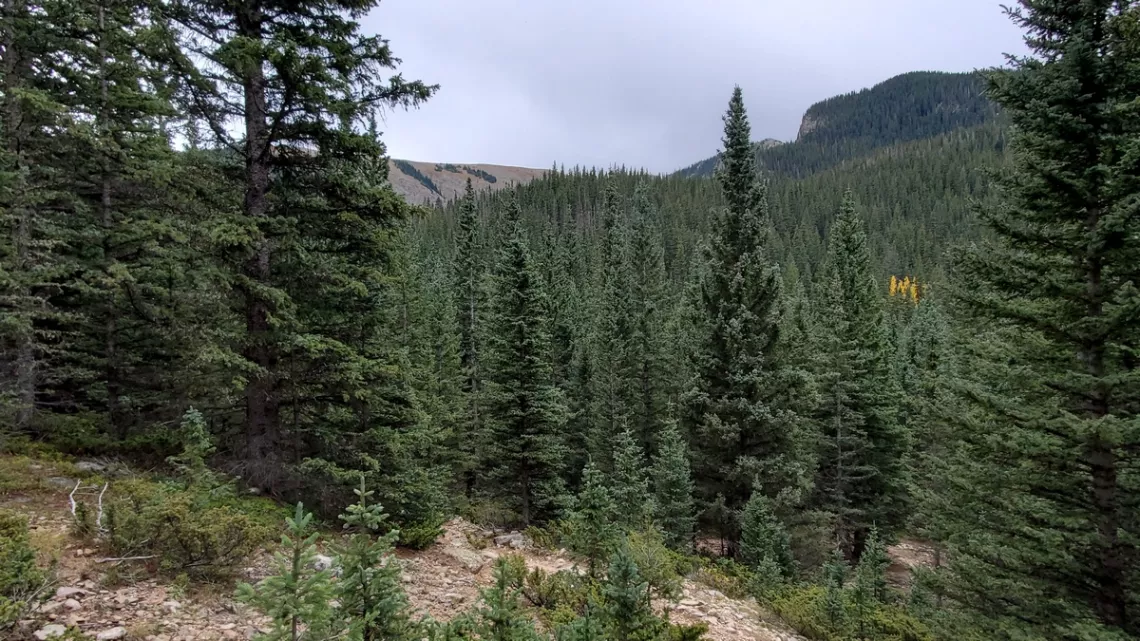
Stuff to the west: Bandelier National Monument and Valles Caldera National Preserve
Northwest of Santa Fe and southwest of Taos is Los Alamos. Just southeast of the the latter we can go south on hwy 4 to Bandelier National Monument. Just west of Bandelier is Valles Caldera National Preserve (article May 2023). Here's the Bandelier geology page which explains what all happened here over a million years ago; this is all on account of the eruption of what is now of Valles Caldera.
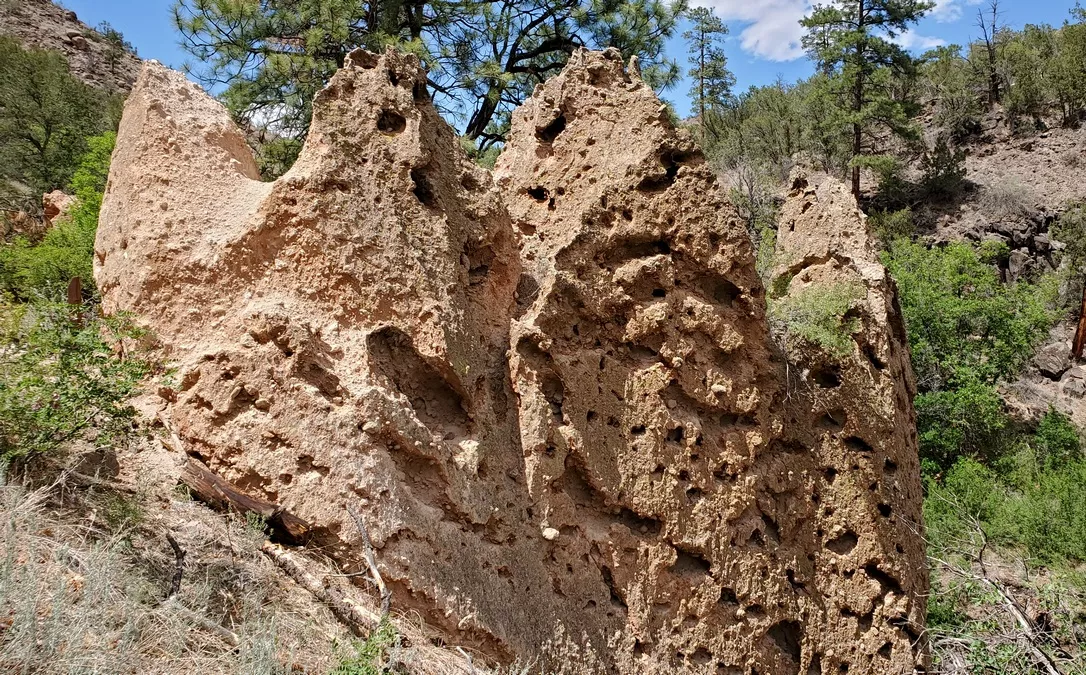
In the northwestern corner of the state: Salmon Ruins, Aztec Ruins National Monument and Shiprock
Forty miles east of the town of Shiprock (next section) on US 64 we are at the Salmon Ruins museum just west of Bloomfield. Believe I read in The Chaco Meridian by Stephen Lekson the opinion that Salmon Ruins was an initial northern terminus of the meridian, then wiped out by a flood of San Juan River. Then people moved north and built structures now in Aztec Ruins National Monument on the north side of the city of Aztec, 10 miles north of Bloomfield along US 550.
In Archeology Southwest there is an article on Salmon Pueblo, PDF. This nicely covers not only Salmon but the greater Chaco context and connection with later civilizations including Mesa Verde.

In the 1920s the grand kiva at Aztec Ruins National Monument (next picture) was in terrible shape, deteriorating due to fallen roof and and wall materials. An NPS history article talks about a decision in the 1930s to not simply stabilize and restore as much as possible but entirely reconstruct it. A lovely job; we can imagine ceremonies proceeding within. Surely some good guidance was obtained regards the design but maybe we should not assume it is now as was originally.
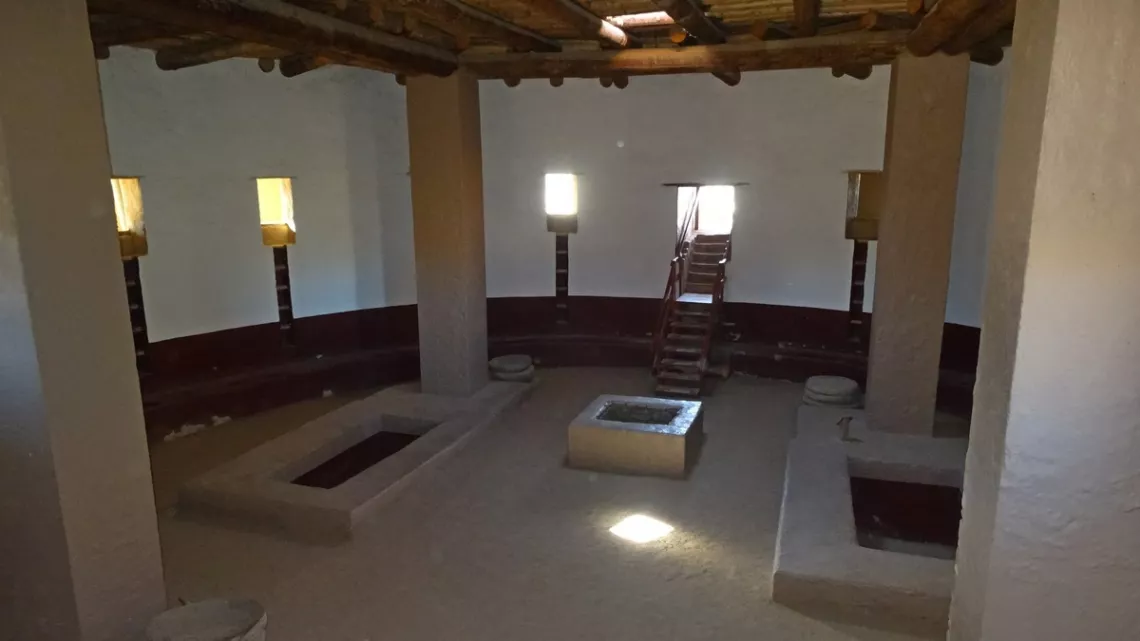
Shiprock!
This is an isolated mountain comprised of volcanic rock (picture below), the erosional remnant of the throat of of a volcano. Peak elevation 7178', base about 5500'. It is 11 mi southwest of the city by the same name, and 24 mi southeast of the Four Corners (intersection of Utah/Colorado/New Mexico/Arizona state lines).
First ascent was by a Sierra Club group including David Brower in 1939 (Wikipedia). David was the first executive director of the club, 1952-1969. Another member of the group, Bestor Robinson, wrote an explanation of the route and challenges (American Alpine Club), originally published as A Bent Piece of Iron, Saturday Evening Post, 1939. The gear included 1100' of rope, 54 pitons and 4 expansion bolts. This was the first climb in the US to use bolts (for belay anchors, hopefully saving a climber in the event of a fall, after placement above the trickiest sections). This took 4 days, with the last 2 nights being spent on the mountain.
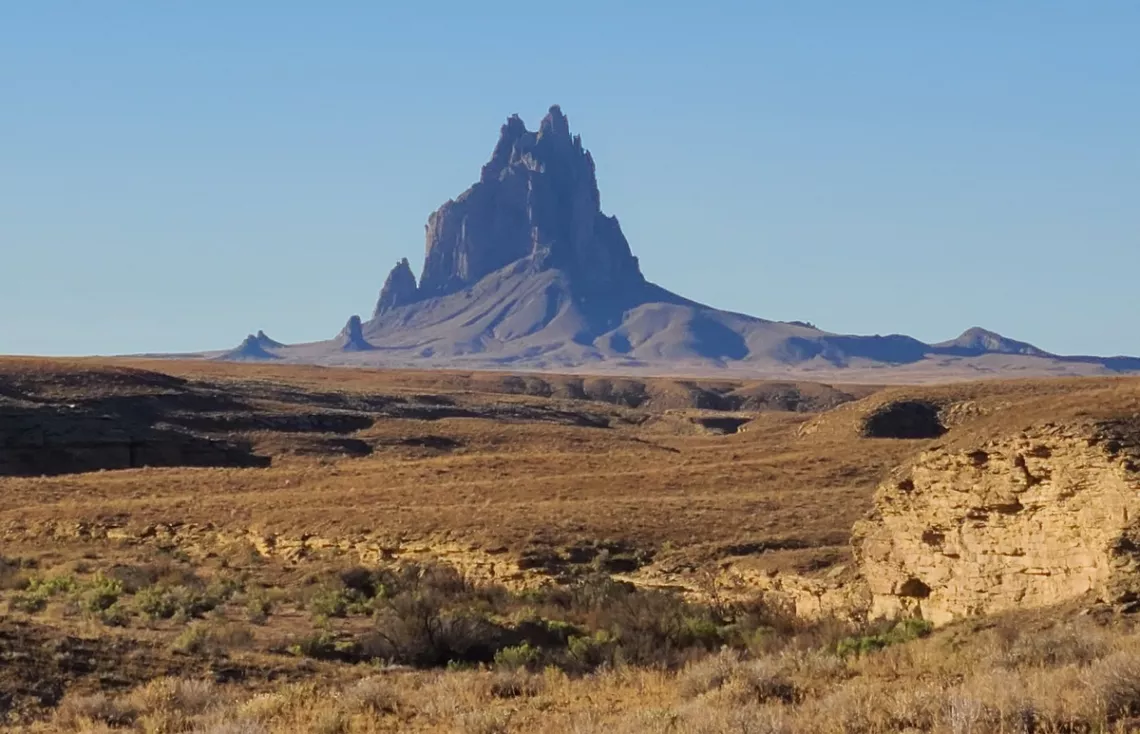
Coming back southeast, couple more spots
From the town of Farmington, between Shiprock and Bloomfield on US 64, we can drive south on US 371. 37 miles south we are at the turnoff east for the main entrance to Bisti/De-Na-Zin Wilderness (article November 2019).
Another 42 miles south along US 371 is the turnoff east for hwy 57, after 11 miles hwy 57 turns north to Chaco Culture National Historic Park (article October 2019), 33 miles total from US 371. To Chaco from the east it is 32 miles along county rds 7900 and 7950 from US 550 just south of Nageezi.
Coming back to Texas through New Mexico there are another thousand interesting bits we might visit. I've only seen a little fraction of all that. What is mentioned above resulted from maybe 12 trips.
by Kevin Hartley, Sierra Club Life Member
Outings: The Call of the Wild
Visit the Alamo Sierra Club Outings page on Meetup for detailed information about all of our upcoming Sierra Club Outings.
The Alamo Sierran Newsletter
Richard Alles, Editor
Published by the Alamo Group of the Sierra Club, P.O. Box 6443, San Antonio, TX 78209, Website.
The Alamo Group is one of 13 regional groups within the Lone Star Chapter of the Sierra Club.
Changed your contact information?
If you're not sure whether the Sierra Club has your current email address, send an email to Member Services with your name and address and/or member ID (see Locating Your Member ID) so they can add your email address to your member record.
Have you moved? Let us know by sending your old address, your new address and your member ID to: address.changes@sierraclub.org.
Go online for the latest news and events
 |